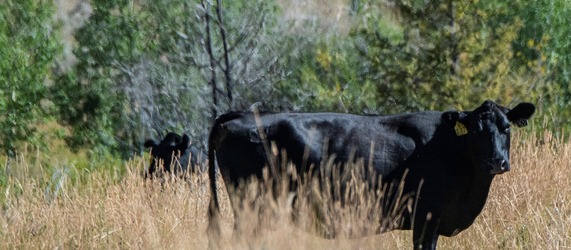|
(Image 1. USDA Conservation Reserve Program Field Flowers, Hayes County NE. Kristen Tam UNL)
Water and Agriculture Information Center (WAIC)
September 2023
Pollinators are critical to the survival of more than 80% of the earth's flowering plants and trees (USDA Forest Service). Coevolution between animals and plants has resulted in pollination niches where certain flowers and fauna can only be fertilized by a subset of pollinators. Conversely, those plants and trees may be the sole food source for the pollinator. While production agriculture has many ecosystem benefits, it is categorized as an environmental stressor that can affect pollinator health and habitats. Agricultural landscapes that significantly alter, disrupt, or eliminate pollinator-specific habitats and food sources can damage the pollination niche and, ultimately, the survival capacity of both pollinator and plant.
Agricultural Environment Management (AEM) combines farming and ranching systems with scientifically based best management practices to promote economic viability while conserving natural resources. AEMs include integrated pest management practices, adjusting landscape practices to reduce environmental disturbances, and ensuring native plant diversity in grazing lands. In addition to conducting AEM-related research, and providing outreach and extension assistance, the USDA administers conservation programs designed to improve pollinator habitats by using AEM practices and native vegetation. There are approximately 550,000 acres of U.S. farmlands currently enrolled in habitat programs which help strengthen and protect pollination niches across the nation.
_______________________
Visit the WAIC webpage to learn more about ongoing research designed to conserve natural resources and protect ecosystems within a thriving agricultural network.
Specific topics include:
- Conservation Effects Assessment Program (CEAP)
- Long-Term Agroecosystems Research (LTAR)
- National Water and Climate Center (NWCC)
Read More on Pollination Niches
- Harder, L.D. and Johnson, S.D. (2009), Darwin's beautiful contrivances: evolutionary and functional evidence for floral adaptation. New Phytologist, 183: 530-545.
- Phillips, R. D., Peakall, R., van der Niet, T., and Johnson, S. D. (2020). Niche perspectives on plant-pollinator interactions. Trends Plant Sci. 25(8): 779-793.
Specialized Funding and Incentive Programs
Are you a farmer or rancher interested in enhancing the environmental and conservational impact of your land? Check out the Agricultural Funding Resources by Topic webpage for a list of specialized funding and incentive programs under the “Water and Agriculture” dropdown menu on:
- Conservation Reserve Program
- Environmental Quality Incentives Program
- Climate Smart Commodities funding
 Questions or comments? Do you have topics you would like to have highlighted?
Contact the WAIC team: waic@usda.gov
|